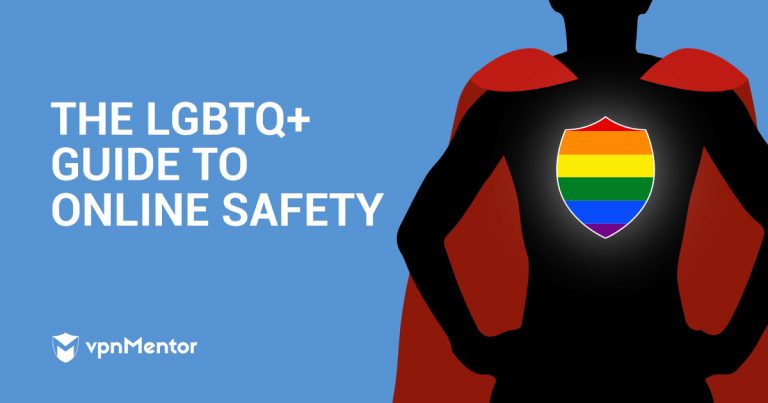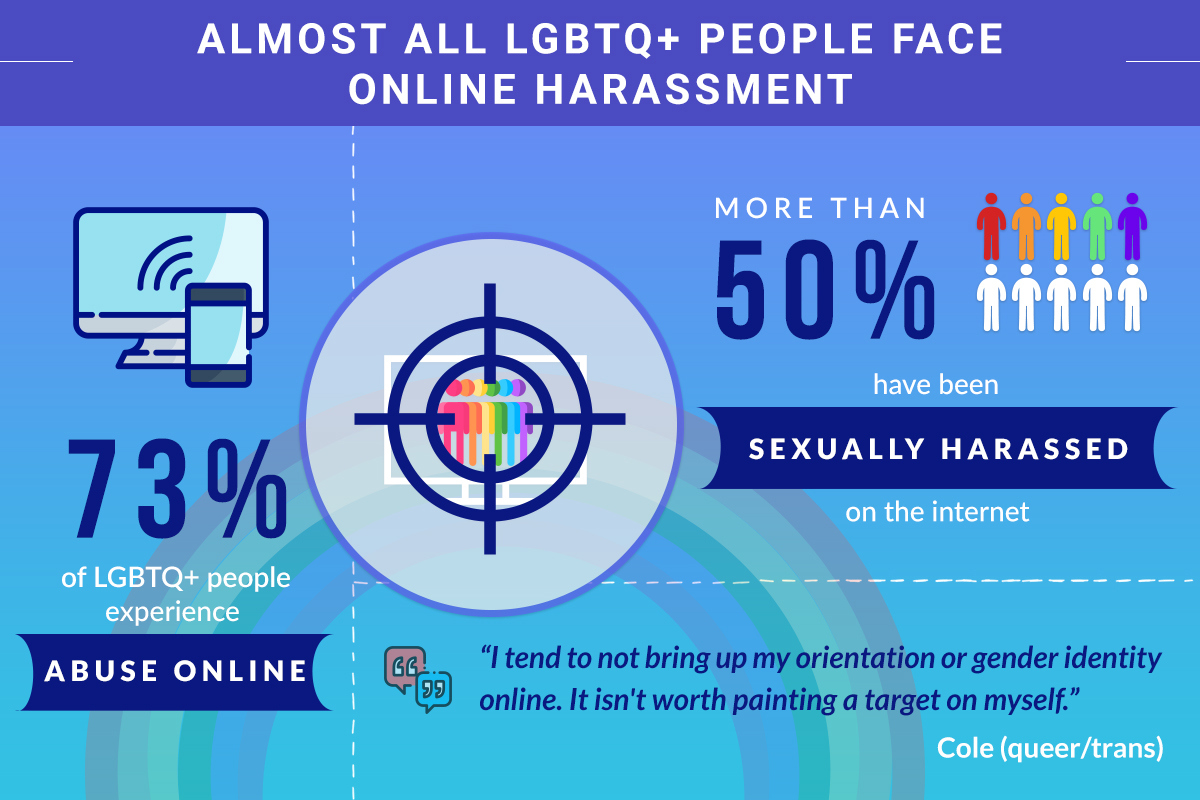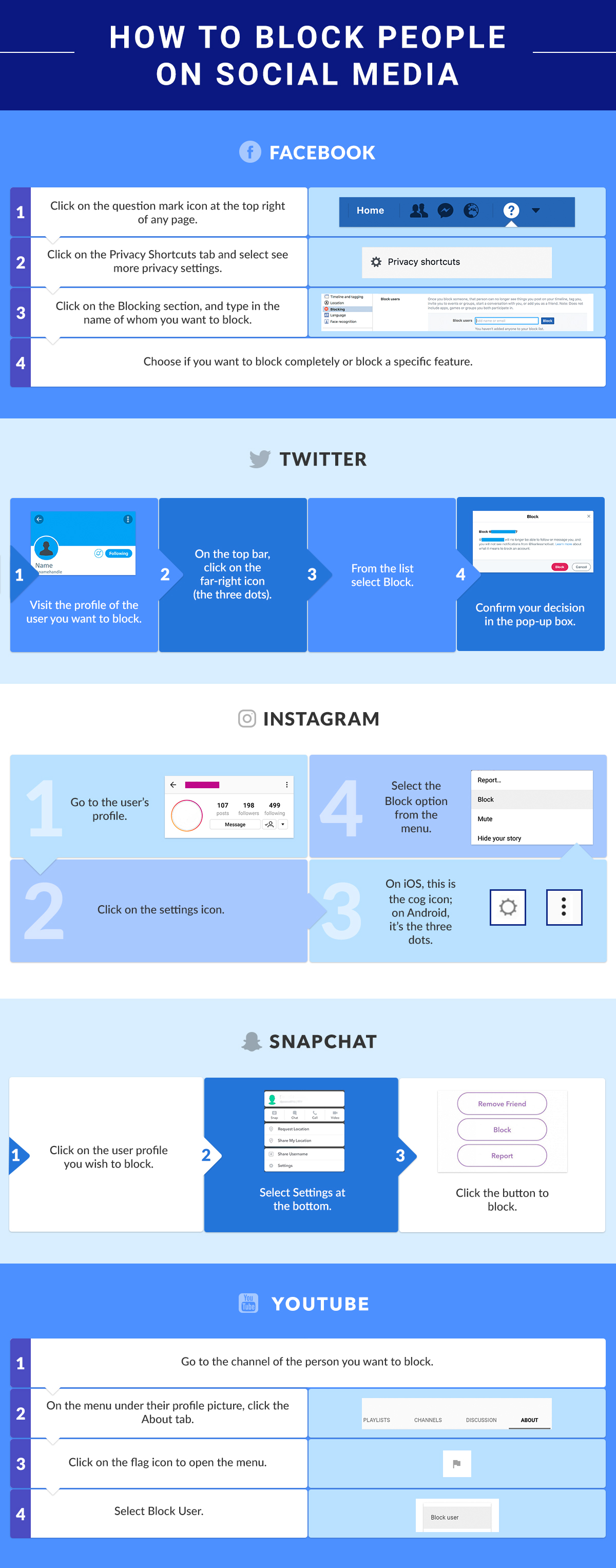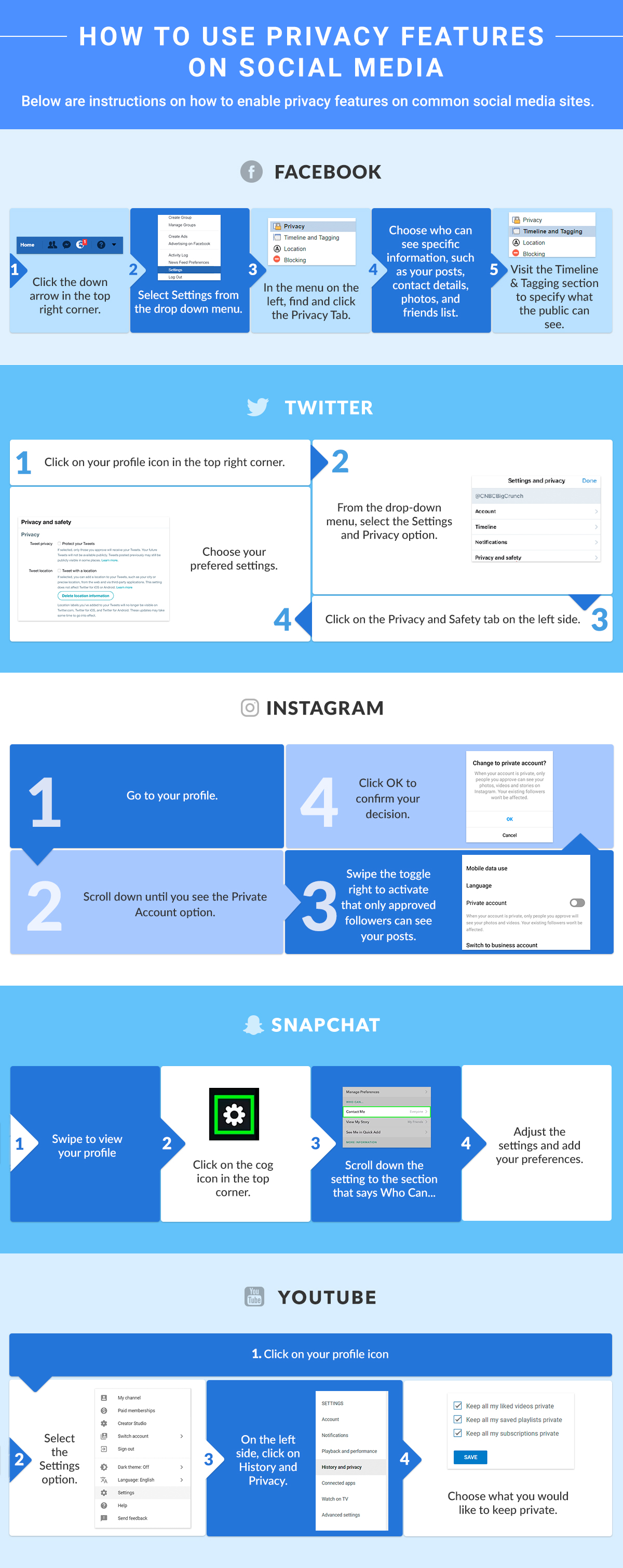LGBTQ+ guide to online safety
Colin Stewart is a 45-year journalism veteran living in Southern…
Most LGBTQ are Cyberbullied.
Here’s How to Stay Safe Online

- The scope of the problem
- Combating cyberbullying on social media
- Using privacy controls to avoid blackmail and harassment
- Dating while queer
Part 2 of the guide is a separate post that discusses:
- How to avoid getting hacked
- Avoiding unwanted advances
- On the job while queer
- A short guide for parents of queer kids
1: The scope of the problem
A survey by vpnMentor of 695 LGBTQ+ people worldwide about their experiences online revealed many unique challenges faced by the LGBTQ+ community. It found that:
- 73% of all respondents in all categories of gender identity and sexual orientation have been personally attacked or harassed online.
- 50% of all respondents in all categories of gender identity and sexual orientation have suffered sexual harassment online.
- When it comes to sexual orientation, asexual people feel the least safe online, and gay men the safest.
- When it comes to gender identity, transgender women feel the least safe online, and cisgender men the safest.
- Transgender women are the most likely to be outed against their will online, while cisgender men are least likely.
+For complete results, see the report’s appendix.
Finding Community Online
Navigating a heterosexual and cisgender society can be difficult for members of the LGBTQ+ community. Alienated from their family, condemned by their community, and isolated from their friends, many LGBTQ+ people turn to the internet for solidarity.
With just the click of a button, they can escape their physical surroundings and immediately be transported to a place filled with like-minded, accepting people. There, they can seek guidance about coming out, ask questions about queer specific topics, and better understand their sexualities and gender identities.
Simply put, the internet facilities a sense of community among LGBTQ+ people, regardless of their physical proximity to one another.
“The internet and social media are essential to connecting individuals to information and people of the LGBT+ community,” states Mara,* who’s bisexual/pansexual [ategories that are combined in the survey. *All names have been changed to protect individuals’ privacy.] “[It provides] spaces for them to find acceptance, community, and support. It is extremely important to keep these connections alive.”
Since the suicide rate for LGBTQ+ youth is substantially higher than that of their heterosexual and cisgender peers, the internet can literally become life-saving.
“There are so many wonderful support groups that help so much, they seriously saved my life and made my search for my identity so much easier,” recounts Mariela, a lesbian.
“[The internet is] definitely a great information sharer for our sometimes disjointed community, especially in rural areas,” says Blair, who’s genderqueer/non-binary [categories that are combined in the survey] “Lots of my trans identity was discerned through language I accessed online as well as looking at other trans narratives online.”
The Dark Side of the Web
However, the internet can also be an intimidating and dangerous place. Just read the comments on any viral social media post and you’ll see a slew of insults and misdirected aggression.
Considering the fact that a large portion of these hateful comments include homophobic and sometimes even biphobic slurs, the internet is especially threatening to the LGBTQ+ community.
“I feel like there is a significant amount of intolerance from within the LGBTQ community” explained Gill, a genderqueer lesbian. “I’ve honestly been attacked more from within the community than outside of it.”
Given this ugly reality, it is essential that all LGBTQ+ people know how to defend and protect themselves online. Therefore, this guide is aimed at minimizing your personal exposure to online bullying and harassment.
It’s important to note that some of the advice here is aimed at people who do not feel safe enough to come out, or who prefer not to reveal certain aspects of their identity if they feel threatened. It is by no means an encouragement to stay closeted.
The survey revealed some downsides of playing it safe. According to our survey, while self-identified gay people responded that they felt safest online, some believe it’s because they’re overly cautious about their internet activity.
“I haven’t experienced anything negative online,” explains Harris, who’s genderqueer and gay. “[But it’s] because I’ve worked very hard to not put myself in situations where I might be vulnerable to attack. This sort of extra mental effort keeps me safe online, but it does come at a price.”
It is our hope that one day none of this will be relevant, and all people, no matter their sexual orientation or gender identity, will feel free to express themselves online in any way they see fit, without fear.
Cyberbullying is a Near-Universal Experience
According to the study, 73% of LGBTQ+ people have reported being personally attacked or harassed online. These incidents frequently revolve around attempts to alter or criticize a person’s sexual or gender identity.
Shauna, a lesbian respondent recalls, “some lady commented on a post I made on social media that my being gay was a phase and that if I found Jesus, I would be converted just like her.”
“Back before Facebook filtered messages from people you aren’t friends with, I would often receive messages calling me a dyke or similarly abusing me,” adds Dylan, a non-binary respondent.
And the abuse isn’t always just verbal. Sometimes, it can even lead to physical violence. According to Zsófia, a genderqueer/non-binary lesbian living in Hungary, “In 2012, my whole Facebook profile was published (with several other [members of the] Hungarian LGBTQ+ community) on a far-right group’s website. The list was called “fagot-list” (“köcsög lista” in Hungarian).”
In addition to these assaults by bigots and religious and political extremists, the survey found that most of the online harassment respondents experienced was sexual in nature.
“I’ve gotten dick pics when looking for a roommate or when posting my phone number after my cat went missing. I’ve also been told by a few guys’ [that] bisexuality is a phase and I need a good dick to cure me,” explains a Jamie, who’s non-binary and bisexual.
Jamie’s sentiment was echoed throughout the survey, with dozens of people reporting that they have received unsolicited pornographic photos or vulgar, sexually explicit messages.
“I posted a photo saying I wish I could just keep my mouth shut, and multiple people offered their dick to keep it full,” recounts Tamika, a genderqueer lesbian.
“I have had death threats against myself and my family,” discloses Nova, an asexual transgender woman. “Bullying from outside and inside the community. [I’ve] been creeped out so much that I have left social media.”
Asexual people described feeling threatened by their non-asexual counterparts who refuse to accept asexuality as a valid orientation. Some of these men, women and non-binary or genderqueer people would accuse asexuals of having a latent or “not yet developed” sexual interest.
“People think they can cure my asexuality by sending me their nudes or just repeatedly telling me everyone has a sex drive you just need to wait for yours,” says Elijah, who’s genderqueer and asexual.
Despite reporting frequently receiving sexually inappropriate content or comments, many respondents downplayed their harassment and even excused this behavior as “just the usual.”
But you don’t have to accept “just the usual.” There are ways to filter out the abuse.

2: Combating cyberbullying on social media
Cyberbullying on Social Media
Today social media is our main form of communication on the internet, and for LGBTQ+ people – especially those who are not supported by their families or friends – social media may be the only place they can find a loving, supportive community.
Unfortunately, social media is also rife with bullying. Studies have even shown that, due to the fact that not having to face their victim in person emboldens many abusers, bullying is much more widespread online than in real life.
Research has also shown that cyberbullying causes depression, and many victims turn to unhealthy coping mechanisms such as drugs, alcohol, and self-injury.
While there is no way for individuals to stop the harassers from bullying in the first place, there are ways to shield yourself from them, making the repercussions of cyberbullying less severe.
Sometimes it’s as simple as blocking and reporting abusive users, so you don’t have to interact with them at all.
If problems persist, you also have the option of reporting the abuse to the platform – though unfortunately, site administrators don’t always take the necessary action to shut bigots down.
Other Ways to Silence Haters
When blocking someone online is not an option, there are other steps you can take to limit your exposure to them. Any of the following tactics can help you take control online:
- Manually remove comments on your posts.
Most sites allow you delete specific comments, so you can remove the offensive responses quickly. - Report the incident to the platform.
If you don’t want it to be obvious that it was you who took action, reporting allows you to anonymously flag the issue, so the company can take action. - Create private lists and groups.
Most social networks have a feature to make messages, posts or groups private. By doing this, you can choose to include people you trust and keep potentially sensitive conversations away from harassers.
Cyberbullying on Online Forums
Online forums are a fantastic way to interact with your community, but they can often be a catalyst for arguments and discussions that can turn nasty. It’s not uncommon for LGBTQ+ people to be unfairly targeted on public boards, just because of how they identify.
LGBTQ folks should never be forced to mask their identity, but unfortunately, the world can be a very ugly place, and some people may choose to keep certain information private in order to keep themselves safe.
The following are all details that you should consider avoiding when talking to people you don’t know.
- Address and Contact Information: Cyberbullying is one thing, but having an aggressor know where you live – or how to contact you – can put you in physical danger. Never share these details with anyone online, unless you know them personally and it’s via an encrypted chat. Even general information, such as your town or city, can be used to locate you, so keeping it to yourself is the safest option.
- Real Names:People can quickly connect the dots to work out who you and your friends are, so some choose to use pseudonyms for themselves and people to whom they refer in their posts. This simple habit is easy to adopt and will afford you considerable privacy, while still allowing you to share your experiences and opinions.
- Links to Social Media: If you’re commenting in forums, consider not linking your social media account, or at least keeping your social media settings private. While being verbally attacked on a thread is one thing, your social media account usually has a lot more personal information about you that could escalate harassment to a different level.
3: Using privacy controls to avoid blackmail and harassment
Closeted People Risk Being Blackmailed
Although more and more people are comfortable coming out of the closet, there are still many who unfortunately do not feel safe enough to do so. And there are cyber criminals out there who are ready to take advantage of that and are actively looking for victims to blackmail and extort. Therefore, it is important to know how to keep certain information private if you so choose.
Most online platforms have started to take privacy seriously and offer settings to hide parts of, or all, profile information from some users.
Controlling Your Identity During and After Transition
For many transgender people, the period of transition can be an extremely vulnerable time. For those who prefer to keep some or all of their transition private, the possibility of being outed is one of the biggest threats to their online safety. In fact, 26% of transgender women and 21% of transgender men report having been outed against their will.
Some of the respondents to our survey shared stories about how their friends and classmates maliciously revealed their gender identity on social media platforms – or even blackmailed them.
According to Dante, a bisexual/pansexual trans man, “The person [blackmailing me] said they will share my personal information (gender identity and sexual orientation) if I [didn’t] do some certain things.”
In order to avoid being outed, which could potentially create a hostile family dynamic, cost them their job, or instigate a barrage of hateful messages, many choose to live in secrecy.
As Jolene, a transgender lesbian woman recalls, “I live stealth. I hide my sexual orientation and gender identity online.”
Because most people transition as adults, they very likely have an online presence that presents them with the gender they were assigned at birth. As a result, those who fear being blackmailed or involuntarily outed will often choose to remove their previous identity from the web.
For instance, Bianca, a trans blogger, created an online community where she was able to help others in the same situation as her. However, it eventually led to an inability to secure employment and feed her child. According to her, “Then came reality. The world does not like trans – does not understand the cause or the effect.” Because of this, she made the decision to remove traces of her trans identity from her online presence.
Similarly, Yahel, who’s a trans man, first came out in an online forum he worked for, and was immediately met with harassment: “They started opening topics about me saying I’m a girl and that I have a mental illness; they used ‘she’ pronouns.”
Fortunately, because he was a staff member, he could block the offending users.
However, he also noted the limits to his abilities, observing, “when I left my position as a staff member in order to focus on my grades at school, the harassment continued, and I couldn’t do anything about it. When I reported it, no one did anything about it.”
If you are in a similar situation, and are afraid of the consequences of exposing your assigned gender or transition, you have the option of modifying your online persona.
How to Reinvent Your Online Identity
- Delete your social media accounts and create new ones that reflect your true gender. Start posting more photos, so you have memories to pad it out with!
- Contact websites that present you with your assigned gender, and ask them to remove or update their information on you – you can find out what’s on the web by Googling yourself.
If you don’t want to take these steps because you’ll lose your online following or contact list, you could just update your current accounts.
- If you changed your name, update it on every account.
- Delete or untag old photos from your social media accounts.
- Contact websites, friends, and followers to delete or untag any images that you can’t untag yourself.
- Create new photos, videos, and posts that reflect your true self.
- It’s also good to know that some social media platforms, like Facebook, have the option to choose a custom gender.
Fortunately, with greater trans visibility, more and more people are open about and proud of their journey. Alex is a trans woman, who found it was easy to come out online. According to her, “Changing my identity online was very simple for me mainly because I already surrounded myself with supportive people. So, like, when I did change everything, everyone was already on board.”
Although she did experience some hate – particularly on dating sites – by being open and finding support among her friends, she found it easier to filter out the noise. Furthermore, she chose the keep posted photos that presented her with the gender she was assigned at birth, and even said that it seemed to help her parents adjust to the idea of her transition.
The decision about how open to be online is deeply personal, and no one should be pressured to reveal more or less than they feel comfortable with. You should decide what’s best for you.
4: Dating while queer
Dating While Queer
Online dating is a huge part of modern relationships. Apps, dating websites, and social media all provide a platform for folks of any gender or orientation to meet, hook up, or fall in love. And they can be especially helpful for sexual minorities looking to find partners in a largely cis-hetero world.
Many of the people interviewed who are in happy, long-term relationships met their partners on the web.
Ronnie found the love of her life online. “Once I decided to just talk to someone who I had judged was way out of my league. After a couple of weeks she asked me on a date […] now 6 months later, I’m so unbelievably in love.”
Unfortunately, however, online dating sites can be hives for sexual harassment.
In the survey, more than 50% of respondents who identify as gay, lesbian, queer, asexual, or bisexual/pansexual suffered sexual harassment online.
Similar studies revealed that sexual harassment affects a third of LGBTQ youth – four times as many as cis-hetero youth.
That’s why it’s so important to protect yourself online. Dating should be fun. In order for it to stay that way, check out the tips below.
Safety Tips for Online Dating
Meeting someone you first connected to online could potentially be risky. Even if they appear legitimate, there’s no way to guarantee the authenticity of their identity, and – even if they are the person they say there are – you don’t know how they might act or behave in a face-to-face encounter.
While this shouldn’t stop you from meeting new people, it’s important to maintain a strategy to staysafe, should the situation take an unwanted turn.
- Don’t meet at home because you don’t want strangers to know where you live until you’ve vetted them. It may seem inconvenient, but it will make you much less vulnerable.
- Tell a friend all the details of the arrangements, including who you’re meeting, where you’re meeting, and when you should be back.
- ‘Ask For Angela’ or use a similar scheme. Across the world, codes exist that allow you to discreetly ask for help at bars or restaurants should you feel unsafe during a date. Research the options used in your locale beforehand.
- Use police apps such as SafeTrek (see below), which allow you to notify the police of your location and alert them to danger, without having to make a call. By pressing a single button, you can dispatch authorities without your date knowing.
- Do your research before you meet. Most people have an extensive social media presence that you can use to validate their identity. If they don’t, then you know to be extra cautious during your date – or you might decide to skip the meeting altogether.
Safe Dating Apps
As more and more people rely on their smartphones, dating apps have largely taken the place of traditional dating websites. Some of these attract users who are looking to just hook up (and if that’s what you want, great!), while others are geared more towards those looking for long term relationships.
In either case, users are vulnerable to the same dangers, including sexual harassment or assault.
Fortunately, there are a plethora of apps designed to make your dating experience safer. These include online dating platforms with built-in security measures, as well as intuitive programs that can track your safety while you’re out.
- Taimi: Cited as the biggest and safest dating app for men seeking men, Taimi lets users “make friends, find the perfect guy, or form meaningful relationships.” It uses secure login features, such as fingerprints and two-factor authentication, and has an AI bot to verify accounts and detect fraudulent users.
- LGBTQutie: This simple app promotes cultivating meaningful relationships and friendships, rather than impersonal hookups. It’s aimed at inclusivity, supporting asexual, non-binary, pansexual, and intersex users, alongside other LGBTQ members.
- Scissr: Catering specifically to lesbians, Scissr promises to be a safe space for women. It prioritizes finding fake profiles by weeding out and deleting them before they can cause problems. Alongside its dating service, it also offers users a community where they can share and discuss different topics with likeminded people.
- Chappy: Chappy aims to change the stigma around gay-dating apps. They require each user to verify themselves via Facebook and they auto-delete any pictures that do not include a face. They also require users to each select one another before any messaging can happen, which significantly reduces the chance of harassment. Furthermore, they’ll alert you if anyone tries to screenshot your profile or photos.
Safe Sexting
With the rise of dating apps, sexting has become a common phenomenon. As a result, many have nude pictures stored on their phones.
Whether you take these pictures for yourself or for others, you can’t ignore the possibility that if they fall into the wrong hands, the result could be embarrassing – or in some cases – have devastating effects on your personal or professional life.
But swapping cheeky photos can be a fun and fulfilling part of your romantic life. Just make sure you take precautions.
Apps to Secretly Store Your Photos
There are certain apps that you can use to increase security and store your intimate photos in a locked part of your phone. The following all provide this feature:
- KeepSafe: KeepSafe provides an easy way to protect your pictures. Just transfer your intimate photos into the app, and it will lock them with a password.
- Gallery Lock Lite: This app is a locked photo vault. It also features a stealth mode, which hides the app icon altogether – you can then only access it through a specific sequence of key commands.
- Best Secret Folder: This privacy app allows you to hide the app (and your photos) entirely, as it appears on your phone as a ‘Utilities Folder,’ which diverts any suspicion as to what it contains.
- KYMS: KYMS provides the standard locked album features but takes it a step further by appearing as a calculator on your phone’s menu. As long as no one grabs your phone to do some math, your secret photos will remain hidden.
- Vaulty: As well as providing your photos protection, Vaulty also comes with a plethora of editing features. Plus, if you lose your phone, you can restore your pictures from another device.
Have Your Photos Self-Destruct
Often no real need exists to store your nude photos on your phone at all. Once you’ve sent them to the desired recipient, you may not have a use for them. Many apps exist that allow you to take and send pictures, but will automatically delete them from both phones after a certain amount of time. These platforms allow genuinely stealthy sexting:
- Snapchat
- StealthChat
- Wickr
- Kaboom
- BurnChat
However, be aware that there are ways to get around this – meaning that the recipient of your photos could take a screenshot or save them in some other way. So never sext with someone you don’t trust.






Qtalk: Gay Nigerian man seeks help with pain of family rejection